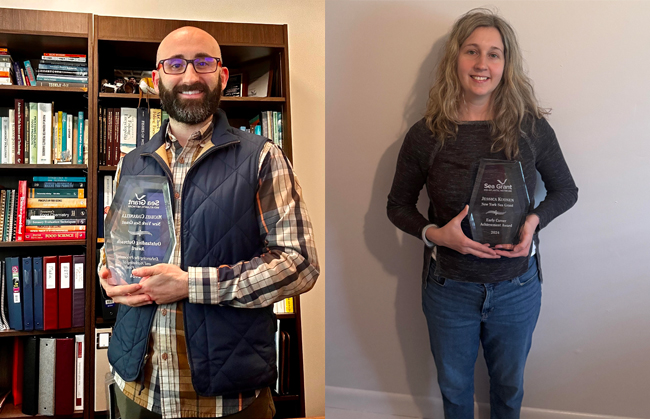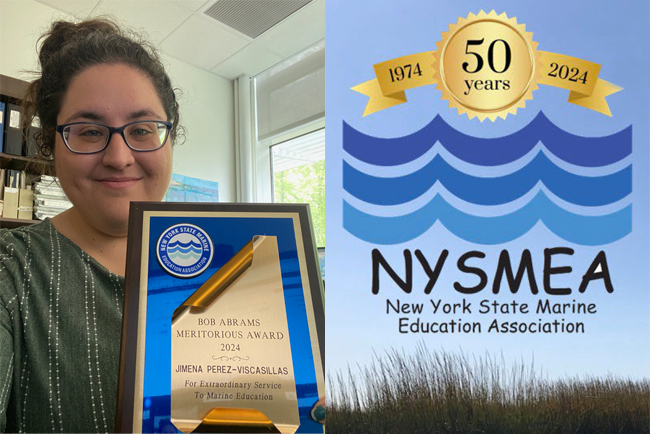Contact:
Michael Ciaramella, NYSG’s Seafood Specialist, E: mc2544@cornell.edu, P: (631) 632-8730
Jessica A. Kuonen, NYSG's Hudson Estuary Resilience Specialist, NYSG E: jak546@cornell.edu, P: (845) 340-3990 x323
Jimena B. Perez-Viscasillas, Long Island Sound Study NY Outreach Coordinator, New York Sea Grant, jbp255@cornell.edu, P: (631) 824-4906
Stony Brook, NY, April 26, 2024 - Three New York Sea Grant specialists were recently bestowed awards, each for his/her exceptional programming efforts.
Two NYSG Extension Specialists Honored at 2024 Mid-Atlantic Sea Grant Conference
Michael Ciaramella, NYSG’s Seafood Specialist, and Jessica A. Kuonen, NYSG's Hudson Estuary Resilience Specialist each received an award at this year's Mid-Atlantic Sea Grant regional conference, held in Ocean City, MD earlier this week.
Ciaramella was bestowed the Superior Outreach Programming Award for his work with New York’s "Opportunities to Enhance the Processing and Marketing of Aquatic Foods" program.
"Ciaramella has a passion for sustainable sources of healthy protein and a vision for New York as a leader in the generation of safe, environmentally friendly, and sustainable seafood products, working with partners and colleagues to make the US less reliant on seafood and seaweed from overseas," said NYSG Associate Director Kathy Bunting-Howarth.
Ciaramella’s efforts to support seafood marketing and consumption both during and after the global COVID-19 pandemic has led to long lasting relationships with all aspects of the seafood industry in New York and the formation of not one but two Task Forces — Seafood Marketing and Seaweed.
Ciaramella regularly brings together industry, commercial fishermen, and academics, with county, state, and federal agency representatives at task force meetings to identify needs, challenges, and opportunities and learn how he can best support these industry sectors. By engaging with these seafood constituencies, listening to their needs, and researching the relevant policies, regulations and permits, Ciaramella has developed marketing and processing guides for seafoods and seaweeds. These include four regulatory guides on wild caught, farmed, molluscan shellfish and seaweed and an additional 11 topical resources elaborating on many of the requirements and concepts outlined in the regulatory guides. NYSG's eight seafood topical guides were translated into Spanish. Fourteen seafood nutrition cards were developed and six existing cards revised and rebranded to create a set of twenty seafood nutrition cards. All cards were also translated to Spanish.
Ciaramella has also hosted eight Seafood Summits where he brings together chefs, restaurateurs, culinary schools, fish mongers, fish processors, commercial fishermen, aquaculturists, and farm markets, as well as city, county, state and federal agency representatives to discuss the latest trends, science, policies, fish health, challenges, etc. related to all aspects of seafood. It’s a comprehensive look at the industry. Ciaramella’s concept has been to link consumers to those that grow or catch while examining every other stop along the “supply chain.”

Also at the conference, Kuonen received the Mid-Atlantic Sea Grant Region’s Early Career Achievement Award.
"Kuonen lives the spirit of extension and deserves this accolade," said Bunting-Howarth. "Her performance during her four and a half years with New York Sea Grant has been wonderful to observe."
When she first joined NYSG, Kuonen was in a split position with the NYS Water Resource Institute. From the beginning, NYSG knew she would excel in the extension profession. She was able to apply her professional GIS experience to co-develop an inundation mapping tool and story map on the record flooding which occurred on Lake Ontario in 2017 and 2019. Within a few months, Kuonen successfully competed to become the second Hudson Estuary Resilience Specialist for NYSG. She stepped into a position which had been filled by the same specialist for over 20 years. However, her position was asked to focus on climate changes versus ecosystem and watershed issues. Kuonen was able to provide much of the excellent service and programming the existing constituents in the estuary expected from NYSG while making the position her own as she grew the program to reach new partners using new approaches and technologies.
COVID-19 did not hold her back from developing her program. As the Hudson Specialist, Kuonen developed curricula and provided training as part of the Cornell Climate Stewards program (a volunteer training program to increase local government capacity to address climate change). She led the development of modules on climate science and climate impacts and then incorporated climate and environmental justice throughout the curricula. Kuonen professionally translated technical, scientific information for the volunteer audience.
During this same time frame, Kuonen took her GIS skills and created a Guide for Using Environmental Justice Mapping Tools (2020) which was designed to help communities, extension professionals, non-profit organizations, and others determine which tools to use to identify communities with different types of environmental stress. The first introductory webinar attracted 249 live participants from across the state representing 81 organizations, which included local, state, and federal government, community-based organizations, consulting firms, educators, and representatives from the health and transportation sectors. Kuonen organized several other webinars since then and has presented at multiple regional Sea Grant meetings.
Kuonen took her passion for environmental justice further and led the NYSG DEIJ team, which produced materials for NYSG's website, designed and organized training for NYSG staff, and guides for staff to more easily enable them to identify and purchase from minority and women owned businesses.
During COVID-19, Kuonen also began participating with the Hudson River Flood Resilience Network (FRN)—a group of local governments working to address flooding and provide a space for them to learn from each other as they strive to increase their resilience. Over the years, she became a trusted source of information and a valued facilitator. In 2022, she was asked to co-facilitate the group and received funding to do so from the Hudson River Estuary Program. Most recently, the FRN approached her to submit a Letter of Intent for the Coastal Regional Resilience Challenge grant, which was encouraged for a full proposal. Under her watch, this network has continued to grow and other communities have requested assistance to create their own networks across the state.
In 2020, NYSG became a FEMA CTP. Kuonen had the winning idea for the first FEMA funded project a Hudson Dynamic Shorelines Story Map Collection. Communities have been using it. And, she has also incorporated a permitting section — something that is especially challenging in New York given our multiple regional state agency varying interpretations of policies and regulations.
Together with Kathleen Fallon, NYSG's Coastal Processes and Hazards Specialist, Kuonen led a NSGO-funded visioning proposal, “Engaging Ci??zens to Monitor and Document Shoreline Flooding and Erosion in the Northeast,” which encompassed the Citizen Science, Community Response to Flooding and the Weather and Climate Enterprise visions. They created a community of practice to learn about different community science approached to collecting and reporting flood information. Since then, Kuonen has led NYSG’s My Coast program and Coastsnap which has included incorporating the photos from the NYC Community Flood Watch data into MyCoast to make that platform a one-stop-shop for the state. Of note, MyCoast was able to document serious flooding from NYC up the Hudson River from a November 2022 storm for which flood warning had not been issued.
Even more impressive, during all these activities Kuonen studied for and passed exams to become a Certified Floodplain Manager.

Jimena Perez-Viscasillas Receives NYSMEA's Bob Abrams Meritorious Award
On April 20th the New York State Marine Education Association (NYSMEA) bestowed the 2024 Bob Abrams Meritorious Award upon Jimena Perez-Viscasillas, NYSG's Long Island Sound Study (LISS) Outreach Coordinator, for her work with the program.
NYSMEA, which held this year's award ceremony at Molloy College in Rockville Center, recognizes people who have achieved extraordinary accomplishments at its annual conference.
The award given this year to Perez-Viscasillas is named in honor of Bob Abrams, who was a founding Member of NYSMEA. Abrams was the longtime director of outdoor education at the Great Neck Public Schools. He created unique science programing which took students into laboratories and out into the marine and forested environments on boats, beaches, and upland campsites.
As one of two outreach coordinators for LISS with NYSG, Perez-Viscasillas works at the intersection of the environment and people. Perez-Viscasillas takes on many tasks for the estuary program, but focuses on environmental education, stewardship, communications, and engagement. She has a BS in Biology from the University of Puerto Rico at Mayaguez and a Masters in Environmental Management from Duke University's Nicholas School of the Environment, where she specialized in community-based environmental management.
In early March, Perez-Viscasillas was NYSMEA's "Speaker of the Month", presenting a virtual webinar entitled "I Spy a Fish: A Snapshot of Participatory Science Opportunities and Tools".
According to the synopsis of Perez-Viscasillas lecture: Environmental management is a team effort. Despite their best intentions, researchers and resource managers cannot be everywhere at once and plentiful data is often necessary to make well-informed decisions to protect the environment. Luckily, there are many programs and tools “citizen scientists” can use to help in the exploration and protection of the world around them. In this talk, Jimena will share some of the participatory science programs and tools that exist in our region, how they help make a difference, and how volunteers can get involved. Opportunities covered will include river herring, horseshoe crab, and diamondback terrapin monitoring, as well as apps to explore biodiversity, help report flooding, and more.
NYSMEA is a 50-year-old organization that represents educators who have an interest in the marine environment. More at www.nysmea.org.
More Info: New York Sea Grant
Established in 1966, the National Oceanic and Atmospheric Administration (NOAA)’s National Sea Grant College Program promotes the informed stewardship of coastal resources in 34 joint federal/state university-based programs in every U.S. coastal state (marine and Great Lakes) and Puerto Rico. The Sea Grant model has also inspired similar projects in the Pacific region, Korea and Indonesia.
Since 1971, New York Sea Grant (NYSG) has represented a statewide network of integrated research, education and extension services promoting coastal community economic vitality, environmental sustainability and citizen awareness and understanding about the State’s marine and Great Lakes resources.
NYSG historically leverages on average a 3 to 6-fold return on each invested federal dollar, annually. We benefit from this, as these resources are invested in Sea Grant staff and their work in communities right here in New York.
Through NYSG’s efforts, the combined talents of university scientists and extension specialists help develop and transfer science-based information to many coastal user groups—businesses and industries, federal, state and local government decision-makers and agency managers, educators, the media and the interested public.
New York Sea Grant, one of the largest of the state Sea Grant programs, is a cooperative program of the State University of New York (SUNY) and Cornell University. The program maintains Great Lakes offices at Cornell University, SUNY Buffalo, Rochester Institute of Technology, SUNY Oswego, the Wayne County Cooperative Extension office in Newark, and in Watertown. In the State's marine waters, NYSG has offices at Stony Brook University and with Cornell Cooperative Extension of Nassau County on Long Island, in Queens, at Brooklyn College, with Cornell Cooperative Extension in NYC, in Bronx, with Cornell Cooperative Extension of Ulster County in Kingston, and with Cornell Cooperative Extension of Westchester County in Elmsford.
For updates on Sea Grant activities: www.nyseagrant.org, follow us on social media (Facebook, Twitter/X, Instagram, Bluesky, LinkedIn, and YouTube). NYSG offers a free e-list sign up via www.nyseagrant.org/nycoastlines for its flagship publication, NY Coastlines/Currents, which it publishes 2-3 times a year.